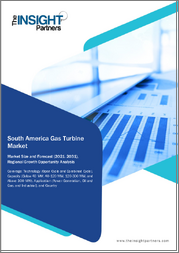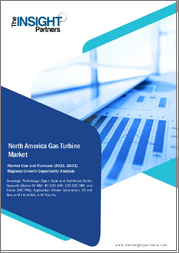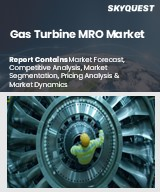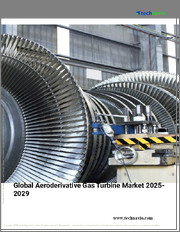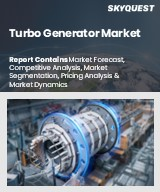
|
시장보고서
상품코드
1715396
가스 터빈 시장 : 제품, 컴포넌트, 정격 출력, 기술, 냉각 시스템, 최종사용자별 - 세계 예측(2025-2030년)Gas Turbines Market by Product, Component, Power Rating, Technology, Cooling System, End User - Global Forecast 2025-2030 |
||||||
가스 터빈 시장은 2024년에는 224억 1,000만 달러에 달하며, 2025년에는 235억 9,000만 달러, CAGR 5.41%로 성장하며, 2030년에는 307억 6,000만 달러에 달할 것으로 예측됩니다.
| 주요 시장 통계 | |
|---|---|
| 기준연도 2024 | 224억 1,000만 달러 |
| 추정연도 2025 | 235억 9,000만 달러 |
| 예측연도 2030 | 307억 6,000만 달러 |
| CAGR(%) | 5.41% |
가스터빈은 전 세계 에너지 믹스 및 산업 용도의 핵심 구성 요소로서 핵심적인 위치를 차지하고 있습니다. 최근 수년간 가스터빈 기술의 발전은 발전 효율의 향상뿐만 아니라 환경 및 운영상의 문제에 대한 혁신적 접근에 박차를 가하고 있습니다. 이 보고서에서는 먼저 시장 현황을 파악하고, 과거 동향과 업계 변화를 촉진하는 새로운 요인을 강조합니다.
고속 추진용 솔루션으로 탄생한 가스터빈이 발전, 국방, 산업 분야에 적용되기까지 가스터빈이 걸어온 길은 기술 발전과 지속가능한 에너지에 대한 수요 증가를 반영합니다. 급속한 도시화와 청정 에너지원으로의 전환에 따라 고효율, 저배출 전력 시스템에 대한 요구가 그 어느 때보다 높아지고 있습니다. 이 종합적인 평가는 기술, 부품 혁신, 시장 역학의 복잡한 상호 작용을 검토하여 업계의 현재 위치와 미래 방향에 대한 명확한 이야기를 제공합니다.
이 소개는 전문가, 의사결정권자, 투자자들이 보다 심층적인 인사이트와 전략적 제안을 모색할 수 있도록 심층 분석의 장을 마련했습니다. 경험이 풍부한 애널리스트이든, 에너지 부문에 처음 참여하는 사람이든, 이 후의 섹션에서는 사업 운영상 과제, 성장 기회, 가스 터빈의 전망을 계속 변화시키고 있는 기술 발전에 대한 균형 잡힌 관점을 제공합니다.
가스 터빈 시장의 변화
가스 터빈 시장은 규제 변화, 기술 발전, 지속가능한 에너지 솔루션에 대한 절박함 증가로 인해 변화의 시기를 맞이하고 있습니다. 디지털 제어 시스템, 재료 공학 및 열효율의 혁신은 역동적인 에너지 부문에서 경쟁 우위를 점하는 데 필수적인 성능 지표의 개선으로 이어졌습니다. 이러한 진화는 단순히 점진적인 기술 강화의 결과라기보다는 전력 시스템이 탄소 배출량을 줄이면서 미래 수요를 충족시킬 수 있는 방법에 대한 근본적인 재검토를 의미합니다.
법적 압박과 세계 환경 문제 해결에 대한 노력으로 인해 엄격한 배기가스 규제 도입이 가속화되고 있으며, 제조업체들은 효율을 높이고 배기가스 배출을 줄이기 위해 터빈 설계를 최적화해야 하는 상황에 직면해 있습니다. 또한 실시간 운전 관리의 고도화된 데이터 분석과 인공지능의 통합으로 보다 효과적인 예지보전 스케줄과 성능 최적화가 가능해졌습니다. 이에 따라 기존 비즈니스 모델이 재검토되고 있으며, 많은 기업이 디지털 전환을 경영 회복력과 시장 경쟁력의 핵심으로 받아들이고 있습니다.
이러한 변화는 에너지 안보에 대한 세계의 관심과 다양한 발전 포트폴리오의 필요성에 의해 더욱 가속화되고 있습니다. 신흥 시장은 R&D에 대한 지속적인 투자와 함께 생산성 향상뿐만 아니라 빠르게 변화하는 규제 및 경제 환경에 대응할 수 있는 적응력 있는 생태계의 기반을 마련하고 있습니다. 요약: 업계 이해관계자들은 혁신적인 기술을 활용하고 운영 프로세스를 재구성함으로써 이러한 진화 압력에 적응해야만 가스 터빈의 미래 전망에서 성공할 수 있습니다.
가스 터빈 시장의 주요 부문에 대한 인사이트 제공
가스 터빈 시장을 이해하는 데 있으며, 매우 중요한 것은 세부적인 세분화를 통해 목표 기회와 과제가 어디에 존재하는지 명확하게 파악할 수 있다는 점입니다. 시장은 제품, 부품, 정격 출력, 기술, 냉각 시스템, 최종사용자 등 여러 측면에서 세분화되어 있습니다. 제품 측면에서는 항공용 가스터빈과 중하중 가스터빈이 명확하게 구분됩니다. 이들 제품 카테고리는 각각 명확한 운영 요구와 성능 기준을 충족하고 특정 시장 수요에 맞는 다양한 효율과 내구성을 제공합니다.
구성 요소를 분석하면 연소기, 압축기, 제어 시스템, 배기 시스템, 샤프트, 터빈 블레이드 등 몇 가지 주요 분야에 성능 및 설계 혁신이 집중되어 있음을 알 수 있습니다. 각 구성 요소는 엄격한 성능 기준과 엔지니어링 진보를 통해 전체 시스템이 가혹한 작동 조건에서도 높은 효율과 신뢰성을 유지할 수 있도록 합니다. 마찬가지로 정격 출력에 따른 분류는 40MW 미만에서 250MW 이상, 41-120MW 및 121-250MW의 중간 범주를 포함하여 뚜렷한 범위의 변형을 조명합니다. 이 구분은 지역적, 기술적 요구 사항을 이해하는 데 있으며, 규모와 발전 용량이 중요하다는 점을 강조합니다.
기술별로 분류하면, 결합 사이클과 개방형 사이클 구성이 구분됩니다. 이 분류는 다양한 용도에 적합한 열효율과 운전 유연성의 조합을 식별하는 데 매우 중요합니다. 또한 공랭식 또는 수랭식 냉각 시스템은 전체 성능, 유지보수 일정 및 비용 효율성에 영향을 미치는 또 다른 중요한 분류 축입니다. 마지막으로 시장 세분화에서는 상업, 국방, 산업, 유틸리티와 같은 최종사용자 부문을 면밀히 분석합니다. 이러한 부문은 각각 운영상의 요구와 규제상 과제를 가지고 있으며, 그 결과 기술 도입과 제품 성능에 대한 접근 방식이 다를 수 있습니다.
이러한 다면적인 세분화 분석은 전략적 의사결정을 지원하는 종합적인 관점을 제공하고, 시장 진출기업이 다양화되는 시장의 미묘한 수요에 대응하는 제품을 제공할 수 있도록 지원합니다.
목차
제1장 서문
제2장 조사 방법
제3장 개요
제4장 시장 개요
제5장 시장 인사이트
- 시장 역학
- 성장 촉진요인
- 성장 억제요인
- 기회
- 해결해야 할 과제
- 시장 세분화 분석
- Porter’s Five Forces 분석
- PESTLE 분석
- 정치
- 경제
- 사회
- 기술
- 법률
- 환경
제6장 가스 터빈 시장 : 제품별
- 항공 파생형 가스 터빈
- 헤비 듀티 가스 터빈
제7장 가스 터빈 시장 : 컴포넌트별
- 연소기
- 컴프레서
- 제어 시스템
- 배기 시스템
- 축
- 터빈 블레이드
제8장 가스 터빈 시장 : 출력 정격별
- 121-250MW
- 41-120MW
- 250MW 이상
- 40MW 미만
제9장 가스 터빈 시장 : 기술별
- 복합 사이클
- 오픈 사이클
제10장 가스 터빈 시장 : 냉각 시스템별
- 공랭식
- 액랭식
제11장 가스 터빈 시장 : 최종사용자별
- 상업용
- 방위
- 산업
- 유틸리티
제12장 아메리카의 가스 터빈 시장
- 아르헨티나
- 브라질
- 캐나다
- 멕시코
- 미국
제13장 아시아태평양의 가스 터빈 시장
- 호주
- 중국
- 인도
- 인도네시아
- 일본
- 말레이시아
- 필리핀
- 싱가포르
- 한국
- 대만
- 태국
- 베트남
제14장 유럽, 중동 및 아프리카의 가스 터빈 시장
- 덴마크
- 이집트
- 핀란드
- 프랑스
- 독일
- 이스라엘
- 이탈리아
- 네덜란드
- 나이지리아
- 노르웨이
- 폴란드
- 카타르
- 러시아
- 사우디아라비아
- 남아프리카공화국
- 스페인
- 스웨덴
- 스위스
- 튀르키예
- 아랍에미리트
- 영국
제15장 경쟁 구도
- 시장 점유율 분석, 2024
- FPNV 포지셔닝 매트릭스, 2024
- 경쟁 시나리오 분석
- 전략 분석과 제안
기업 리스트
- ABB Ltd.
- Ansaldo Energia S.p.A.
- Bharat Heavy Electricals Limited
- Capstone Green Energy Corporation
- Centrax Ltd.
- Danfoss A/S
- Destinus OPRA B.V.
- Doosan Enerbility Co., Ltd.
- Fuji Industries Co., Ltd.
- General Electric Company
- GKN PLC
- Harbin Electric Corporation
- Heinzmann Australia Pty Ltd
- Honeywell International Inc.
- IHI Corporation
- Kawasaki Heavy Industries, Ltd.
- MAN Energy Solutions
- MAPNA Group
- Mitsubishi Heavy Industries, Ltd.
- MTU Aero Engines AG
- Nidec Corporation
- Power Machines
- Rolls-Royce PLC
- Siemens AG
- Solar Turbines Incorporated
- Sumitomo Heavy Industries, Ltd.
- TECO-Westinghouse
- Toshiba Corporation
- Vericor Power Systems
- Wartsila Corporation
The Gas Turbines Market was valued at USD 22.41 billion in 2024 and is projected to grow to USD 23.59 billion in 2025, with a CAGR of 5.41%, reaching USD 30.76 billion by 2030.
| KEY MARKET STATISTICS | |
|---|---|
| Base Year [2024] | USD 22.41 billion |
| Estimated Year [2025] | USD 23.59 billion |
| Forecast Year [2030] | USD 30.76 billion |
| CAGR (%) | 5.41% |
Gas turbines have taken center stage as critical components in the global energy mix and industrial applications. In recent years, the evolution of gas turbine technology has not only catalyzed improvements in power generation efficiency but has also fueled innovative approaches in addressing environmental and operational challenges. This report begins by laying out the current state of the market, highlighting both historical trends and the emerging factors that are propelling industry transformation.
The journey of gas turbines-from their inception as solutions for high-speed propulsion to their current deployment in power generation, defense, and industrial sectors-reflects technological breakthroughs and a rising demand for sustainable energy. With rapid urbanization and a global shift towards cleaner energy sources, the need for highly efficient, low-emission power systems has never been more prominent. As we delve into this comprehensive assessment, the complex interplay of technology, component innovation, and market dynamics will be examined to provide a clear narrative of where the industry stands today and where it is headed tomorrow.
This introduction sets the stage for a deeper analysis, inviting experts, decision-makers, and investors alike to explore the detailed insights and strategic recommendations that follow. Whether you are a seasoned analyst or new to the energy sector, the ensuing sections offer a balanced perspective on operational challenges, opportunities for growth, and the technological advancements that continue to reshape the gas turbine landscape.
Transformative Shifts in the Gas Turbine Landscape
The gas turbine market is experiencing transformative shifts influenced by a confluence of regulatory changes, technological advancements, and the increasing urgency for sustainable energy solutions. Innovations in digital control systems, materials engineering, and thermal efficiency have led to improved performance metrics which are vital for competitive positioning in the dynamic energy sector. This evolution is not solely the result of incremental technical enhancements; rather, it is a fundamental rethinking of how power systems can meet future demand while reducing their carbon footprint.
Legislative pressures and global environmental commitments have spurred the introduction of stringent emission norms, pushing manufacturers to optimize turbine designs for better efficiency and lower emissions. Additionally, the integration of advanced data analytics and artificial intelligence in real-time operational management has enabled more effective predictive maintenance schedules and optimized performance. As a result, traditional business models are being reevaluated, with many companies now embracing digital transformation as a cornerstone of operational resilience and market competitiveness.
This shift is further magnified by the global focus on energy security and the need for a diversified power generation portfolio. Emerging markets, combined with sustained investments in research and development, are setting the stage for not only higher productivity but also an adaptive ecosystem capable of responding to a rapidly changing regulatory and economic environment. In summary, industry stakeholders must adapt to these evolutionary pressures by leveraging innovative technologies and reimagining operational processes in order to thrive in the future landscape of gas turbines.
Key Segmentation Insights in the Gas Turbine Market
A pivotal aspect of understanding the gas turbine market lies in the detailed segmentation that provides clarity on where targeted opportunities and challenges exist. The market is segmented on multiple dimensions that include product, component, power rating, technology, cooling system, and end user. From the product standpoint, the market landscape sees a clear demarcation between Aero-Derivative Gas Turbines and Heavy Duty Gas Turbines. Each of these product categories caters to distinct operational needs and performance criteria, offering a broad spectrum of efficiency and durability tailored to specific market demands.
The analysis of components reveals that performance and design innovation are concentrated across several key areas such as the combustor, compressor, control systems, exhaust system, shaft, and turbine blades. Each component is subject to rigorous performance standards and engineering advances, ensuring that the overall system maintains high efficiency and reliability even under demanding operating conditions. Similarly, the segmentation based on power rating sheds light on variations across distinct ranges: from below 40 MW to values above 250 MW, with intermediary categories in the ranges of 41-120 MW and 121-250 MW. This division underscores the importance of scale and power generation capacity in understanding regional and technological requirements.
Further segmentation by technology distinguishes between Combined Cycle and Open Cycle configurations. This classification is crucial in identifying the right mix of thermal efficiency and operational flexibility for different applications. Additionally, the cooling system, which can either be air-cooled or liquid-cooled, represents another vital segmentation axis that influences overall performance, maintenance schedules, and cost efficiency. Finally, market research carefully dissects end user segments, including commercial, defense, industrial, and utilities sectors. Each of these segments has disparate operational needs and regulatory challenges, which in turn dictate a differentiated approach to technology adoption and product performance.
This multifaceted segmentation analysis provides an all-inclusive view that supports strategic decision-making and allows industry participants to tailor their offerings to meet the nuanced demands of an increasingly diversified market.
Based on Product, market is studied across Aero-Derivative Gas Turbines and Heavy Duty Gas Turbines.
Based on Component, market is studied across Combustor, Compressor, Control Systems, Exhaust System, Shaft, and Turbine Blades.
Based on Power Rating, market is studied across 121-250 MW, 41-120 MW, Above 250 MW, and Below 40 MW.
Based on Technology, market is studied across Combined Cycle and Open Cycle.
Based on Cooling System, market is studied across Air-Cooled and Liquid-Cooled.
Based on End User, market is studied across Commercial, Defense, Industrial, and Utilities.
Key Regional Insights Shaping the Market
Regional dynamics play a crucial role in determining the success and growth trajectory of the gas turbine market. Analysis of the market across different geographies provides deep insight into both mature and emerging regions, each of which presents unique challenges and opportunities. In the Americas, the mature market landscape is characterized by established infrastructure and a strong regulatory framework that emphasizes efficiency and sustainability. Investments in high-performance power systems continue to thrive, driven by a consistent demand for modernization and upgrades to aging facilities.
Moving to the Europe, Middle East & Africa region, the market holds a dual narrative of longstanding industrial capabilities interspersed with rapid modernization efforts in select economies. In these markets, policy-driven reforms aimed at reducing emissions are coupled with aggressive innovation strategies, fostering a competitive environment where both local and global players strive for leadership. The European segment in particular is noted for its high standards in technology and efficiency, while the Middle Eastern and African markets offer growth opportunities through ample reserves and an evolving industrial sector.
In Asia-Pacific, the rapid pace of urbanization and industrial growth creates a fertile environment for gas turbine adoption. This dynamic region is witnessing a surge in investments targeting both new power generation projects and the retrofitting of existing facilities. Government policies in these areas are increasingly supportive of sustainable and efficient energy projects, further accelerating the market's evolution. Taken together, the regional insights provide a comprehensive understanding of how local market drivers, economic conditions, and regulatory landscapes shape the global narrative of gas turbine technology.
Based on Region, market is studied across Americas, Asia-Pacific, and Europe, Middle East & Africa. The Americas is further studied across Argentina, Brazil, Canada, Mexico, and United States. The United States is further studied across California, Florida, Illinois, New York, Ohio, Pennsylvania, and Texas. The Asia-Pacific is further studied across Australia, China, India, Indonesia, Japan, Malaysia, Philippines, Singapore, South Korea, Taiwan, Thailand, and Vietnam. The Europe, Middle East & Africa is further studied across Denmark, Egypt, Finland, France, Germany, Israel, Italy, Netherlands, Nigeria, Norway, Poland, Qatar, Russia, Saudi Arabia, South Africa, Spain, Sweden, Switzerland, Turkey, United Arab Emirates, and United Kingdom.
Key Companies Driving Innovation in Gas Turbines
The gas turbine market is highly competitive and features several companies that are at the forefront of innovation and technology leadership. Key industry participants such as ABB Ltd., Ansaldo Energia S.p.A., Bharat Heavy Electricals Limited, and Capstone Green Energy Corporation have been instrumental in driving performance enhancements and expanding the boundaries of what gas turbines can achieve. These pioneering firms, along with other influential players like Centrax Ltd., Danfoss A/S, and Destinus OPRA B.V., have continuously invested in research and development to deliver products that align with global sustainability and efficiency benchmarks.
Further differentiation in the market is evident through the strategic contributions of Doosan Enerbility Co., Ltd., Fuji Industries Co., Ltd., and General Electric Company. Their innovations have not only set new performance standards but have also streamlined the integration of advanced digital systems within turbine operations. In addition, companies such as GKN PLC, Harbin Electric Corporation, Heinzmann Australia Pty Ltd, and Honeywell International Inc. illustrate the depth of cross-industry collaboration fueling advancements in both hardware and software components of gas turbines.
Other notable contributors include IHI Corporation, Kawasaki Heavy Industries, Ltd., MAN Energy Solutions, and MAPNA Group, all of whom have fostered a culture of continuous improvement in both design and performance metrics. Mitsubishi Heavy Industries, Ltd., MTU Aero Engines AG, and Nidec Corporation further reinforce industry momentum by infusing their global expertise and operational excellence into market offerings. The collective impact of these organizations, supported by technological leaders such as Power Machines, Rolls-Royce PLC, Siemens AG, and Solar Turbines Incorporated, is clear. They consistently push the envelope for efficiency, reliability, and cost optimization, culminating in a robust and forward-looking ecosystem. The contribution of Sumitomo Heavy Industries, Ltd., TECO-Westinghouse, Toshiba Corporation, Vericor Power Systems, and Wartsila Corporation also exemplifies how market competition drives beneficial innovation and collaboration across the entire value chain.
The report delves into recent significant developments in the Gas Turbines Market, highlighting leading vendors and their innovative profiles. These include ABB Ltd., Ansaldo Energia S.p.A., Bharat Heavy Electricals Limited, Capstone Green Energy Corporation, Centrax Ltd., Danfoss A/S, Destinus OPRA B.V., Doosan Enerbility Co., Ltd., Fuji Industries Co., Ltd., General Electric Company, GKN PLC, Harbin Electric Corporation, Heinzmann Australia Pty Ltd, Honeywell International Inc., IHI Corporation, Kawasaki Heavy Industries, Ltd., MAN Energy Solutions, MAPNA Group, Mitsubishi Heavy Industries, Ltd., MTU Aero Engines AG, Nidec Corporation, Power Machines, Rolls-Royce PLC, Siemens AG, Solar Turbines Incorporated, Sumitomo Heavy Industries, Ltd., TECO-Westinghouse, Toshiba Corporation, Vericor Power Systems, and Wartsila Corporation. Actionable Recommendations for Industry Leaders
It is essential for industry leaders to take a proactive stance as the gas turbine market continues to evolve amid rapid technological advancement and regulatory reforms. First, investing in next-generation turbine designs and exploring innovative materials technology can lead to significant gains in both operational efficiency and environmental compliance. Decision-makers should prioritize continuous research and development initiatives that foster integration of digital technologies, such as advanced control systems and predictive maintenance tools, to mitigate downtime and enhance system reliability.
Additionally, companies are encouraged to broaden their market reach by diversifying their product portfolios. Emphasis should be placed on expanding into niche segments defined by varying power ratings, cooling system technologies, and distinct component innovations. Establishing strategic partnerships-especially in regions witnessing strong infrastructure modernization-can enable firms to combine technical expertise with localized market knowledge, thereby optimizing resource allocation and strengthening competitive advantages.
Leaders must also stay attuned to shifts in regional demands and regulatory landscapes. Ensuring that their products meet or exceed emerging environmental standards and efficiency benchmarks is pivotal in long-term sustainability. Engaging in collaborative ecosystems across supply chains that link manufacturers, suppliers, and end users will foster innovation and secure higher levels of operational excellence. Companies should leverage detailed market segmentation insights to enhance product customization, ensuring that each offering is optimally aligned with specific end user requirements, whether in the commercial, defense, industrial, or utilities sectors.
Finally, a robust investment in market analytics and talent development is recommended to stay ahead of rapid industry changes. By harnessing the power of data-driven decision-making and investing in workforce skills, industry leaders can better anticipate market fluctuations and emerging trends, thereby positioning themselves as pioneers in the highly competitive gas turbine market.
Conclusion: Navigating the Future of Gas Turbines
The gas turbine market, driven by incessant innovation and evolving regulatory standards, is poised for a future enriched with both challenges and opportunities. This report has explored the complete spectrum-from the technological breakthroughs and evolving component designs to the intricate segmentation defining product, technology, and end user demands. It is evident that success in this arena requires a multifaceted approach that tackles both operational efficiency and market diversification.
As market dynamics converge around the need for cleaner, more efficient power systems, industry players must remain agile and forward-thinking. Comprehensive regional insights further underscore that varying economic, regulatory, and technological contexts will continue to shape market behaviors on a global scale. In this rapidly evolving landscape, strategic emphasis on innovation, collaboration, and investment in digital transformation is paramount.
Looking ahead, continuous progress will depend on the ability to integrate advanced technologies with proven engineering expertise. Companies that can successfully balance investment in research and development with an adaptive, market-centric approach will not only thrive in the current environment but also set benchmarks for future advancements. What remains clear is that the foundation of long-term success lies in the harmonious blend of technological prowess, strategic foresight, and an unwavering commitment to operational excellence.
Table of Contents
1. Preface
- 1.1. Objectives of the Study
- 1.2. Market Segmentation & Coverage
- 1.3. Years Considered for the Study
- 1.4. Currency & Pricing
- 1.5. Language
- 1.6. Stakeholders
2. Research Methodology
- 2.1. Define: Research Objective
- 2.2. Determine: Research Design
- 2.3. Prepare: Research Instrument
- 2.4. Collect: Data Source
- 2.5. Analyze: Data Interpretation
- 2.6. Formulate: Data Verification
- 2.7. Publish: Research Report
- 2.8. Repeat: Report Update
3. Executive Summary
4. Market Overview
5. Market Insights
- 5.1. Market Dynamics
- 5.1.1. Drivers
- 5.1.1.1. Increasing electricity consumption and need for reliable power generation
- 5.1.1.2. Government regulations and initiatives promoting gas-fired power generation as a cleaner alternative to coal
- 5.1.1.3. High use of energy in industrial activities worldwide
- 5.1.2. Restraints
- 5.1.2.1. Maintenance complexity and functioning issues of gas turbines
- 5.1.3. Opportunities
- 5.1.3.1. Integration of digital technologies including AI and IoT driving smarter gas turbine operation and maintenance
- 5.1.3.2. Surging investments in renewable energy infrastructure complementing gas turbine flexibility and scalability
- 5.1.4. Challenges
- 5.1.4.1. Environmental impact and inefficiency associated with gas turbines
- 5.1.1. Drivers
- 5.2. Market Segmentation Analysis
- 5.2.1. Product: Heavy-duty gas turbines gaining traction in large-scale industrial settings
- 5.2.2. End User: Expansion of petrochemicals and mining sector boosts demand for robust gas turbines
- 5.3. Porter's Five Forces Analysis
- 5.3.1. Threat of New Entrants
- 5.3.2. Threat of Substitutes
- 5.3.3. Bargaining Power of Customers
- 5.3.4. Bargaining Power of Suppliers
- 5.3.5. Industry Rivalry
- 5.4. PESTLE Analysis
- 5.4.1. Political
- 5.4.2. Economic
- 5.4.3. Social
- 5.4.4. Technological
- 5.4.5. Legal
- 5.4.6. Environmental
6. Gas Turbines Market, by Product
- 6.1. Introduction
- 6.2. Aero-Derivative Gas Turbines
- 6.3. Heavy Duty Gas Turbines
7. Gas Turbines Market, by Component
- 7.1. Introduction
- 7.2. Combustor
- 7.3. Compressor
- 7.4. Control Systems
- 7.5. Exhaust System
- 7.6. Shaft
- 7.7. Turbine Blades
8. Gas Turbines Market, by Power Rating
- 8.1. Introduction
- 8.2. 121-250 MW
- 8.3. 41-120 MW
- 8.4. Above 250 MW
- 8.5. Below 40 MW
9. Gas Turbines Market, by Technology
- 9.1. Introduction
- 9.2. Combined Cycle
- 9.3. Open Cycle
10. Gas Turbines Market, by Cooling System
- 10.1. Introduction
- 10.2. Air-Cooled
- 10.3. Liquid-Cooled
11. Gas Turbines Market, by End User
- 11.1. Introduction
- 11.2. Commercial
- 11.3. Defense
- 11.4. Industrial
- 11.5. Utilities
12. Americas Gas Turbines Market
- 12.1. Introduction
- 12.2. Argentina
- 12.3. Brazil
- 12.4. Canada
- 12.5. Mexico
- 12.6. United States
13. Asia-Pacific Gas Turbines Market
- 13.1. Introduction
- 13.2. Australia
- 13.3. China
- 13.4. India
- 13.5. Indonesia
- 13.6. Japan
- 13.7. Malaysia
- 13.8. Philippines
- 13.9. Singapore
- 13.10. South Korea
- 13.11. Taiwan
- 13.12. Thailand
- 13.13. Vietnam
14. Europe, Middle East & Africa Gas Turbines Market
- 14.1. Introduction
- 14.2. Denmark
- 14.3. Egypt
- 14.4. Finland
- 14.5. France
- 14.6. Germany
- 14.7. Israel
- 14.8. Italy
- 14.9. Netherlands
- 14.10. Nigeria
- 14.11. Norway
- 14.12. Poland
- 14.13. Qatar
- 14.14. Russia
- 14.15. Saudi Arabia
- 14.16. South Africa
- 14.17. Spain
- 14.18. Sweden
- 14.19. Switzerland
- 14.20. Turkey
- 14.21. United Arab Emirates
- 14.22. United Kingdom
15. Competitive Landscape
- 15.1. Market Share Analysis, 2024
- 15.2. FPNV Positioning Matrix, 2024
- 15.3. Competitive Scenario Analysis
- 15.3.1. SSE and Siemens Energy Join Forces in Hydrogen-Powered Gas Turbine Innovation to Enhance UK's Clean Energy Future
- 15.3.2. GE Vernova pioneers a green energy breakthrough with its first 100% hydrogen-fueled aeroderivative gas turbine
- 15.3.3. GE Vernova strengthens U.S. energy supply chain with acquisition of Woodward's gas turbine business
- 15.3.4. Russia enters new energy era with domestically produced high-capacity gas turbine to reduce foreign dependency
- 15.3.5. Gauteng Premier Hails Historic Launch of Fordsburg Open Gas Turbine, Adding 50 Megawatts to Power Grid
- 15.3.6. Kuwait Enhances Power Generation Efficiency at Sabiya Plant, Reduces Emissions Equivalent to Removing 16,000 Cars
- 15.4. Strategy Analysis & Recommendation
Companies Mentioned
- 1. ABB Ltd.
- 2. Ansaldo Energia S.p.A.
- 3. Bharat Heavy Electricals Limited
- 4. Capstone Green Energy Corporation
- 5. Centrax Ltd.
- 6. Danfoss A/S
- 7. Destinus OPRA B.V.
- 8. Doosan Enerbility Co., Ltd.
- 9. Fuji Industries Co., Ltd.
- 10. General Electric Company
- 11. GKN PLC
- 12. Harbin Electric Corporation
- 13. Heinzmann Australia Pty Ltd
- 14. Honeywell International Inc.
- 15. IHI Corporation
- 16. Kawasaki Heavy Industries, Ltd.
- 17. MAN Energy Solutions
- 18. MAPNA Group
- 19. Mitsubishi Heavy Industries, Ltd.
- 20. MTU Aero Engines AG
- 21. Nidec Corporation
- 22. Power Machines
- 23. Rolls-Royce PLC
- 24. Siemens AG
- 25. Solar Turbines Incorporated
- 26. Sumitomo Heavy Industries, Ltd.
- 27. TECO-Westinghouse
- 28. Toshiba Corporation
- 29. Vericor Power Systems
- 30. Wartsila Corporation







